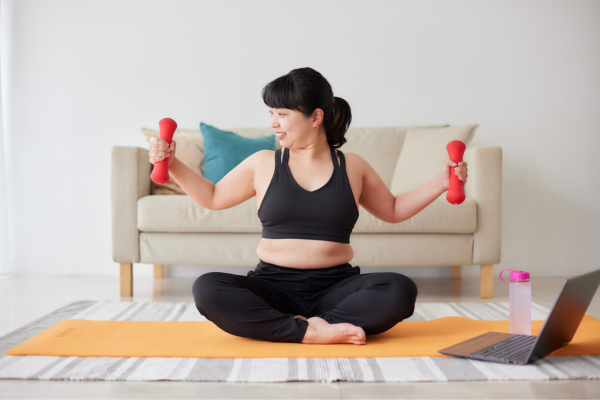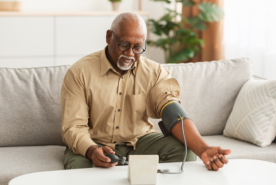October 28, 2025
Discover low-impact seated, bodyweight, and resistance band workouts for people with kidney disease, on dialysis, or post-transplant.
Stay active and strong with these simple, low-impact exercises you can do seated or with resistance bands. Perfect for anyone on dialysis, post-transplant, or just starting their chronic kidney disease (CKD) fitness journey.
Benefits of Exercise for People with CKD
If you have kidney disease, staying active can help you:
- Build muscle and maintain flexibility
- Improve heart health and energy
- Boost mood and reduce stress
Pairing regular exercise with a kidney-friendly diet can also help people with kidney disease maintain a healthy weight, manage blood sugar levels, and improve blood pressure.
Together, these lifestyle habits may help slow the progression of kidney disease.
Subscribe today!
Join the NKF Blog Newsletter
Get inspirational stories and kidney disease resources delivered to your inbox every month. You'll gain practical insights and expert advice to help you better understand and manage your kidney health, no matter where you are on your kidney journey.
Seated Exercises
These exercises are designed to keep you moving even if you have limited mobility or need to stay seated. Seated movements can improve circulation, strengthen muscles, and maintain joint flexibility, without putting stress on the lower back, knees, or feet.
1. Seated Marching
Sit tall in a chair. Lift one knee, then the other, like you’re marching in place.
- Duration: 30–60 seconds
- Appropriate for: People on hemodialysis (before treatment), peritoneal dialysis (PD), and post-transplant (aerobic starter)
- Modifications: Add ankle weights (≤ 2–3 lbs) if tolerated; avoid if very fluid overloaded or feeling lightheaded
2. Seated Calf Raises
With your feet flat, lift your heels off the ground while keeping your toes down. Squeeze calves, then lower.
- Repetitions: 15–20
- Appropriate for: All dialysis types, post-transplant (once cleared)
- Modifications: Add ankle weights if too easy
3. Seated Pelvic Tilt
Tighten your lower belly to flatten your lower back into the chair. Hold, then release.
- Repetitions: 10–15
- Appropriate for: Hemodialysis and post-transplant
- Not recommended: People on PD with a catheter—avoid core strain
- Modifications: Skip if you experience back discomfort or abdominal tension
4. Seated Arm Raises
Raise arms forward or to the side until shoulder height, then lower slowly.
- Repetitions: 10–15
- Appropriate for: All dialysis types, but avoid direct pressure to the fistula or catheter, post-transplant
- Modifications: Use light hand weights (≤ 2 lbs) if comfortable
5. Seated Toe and Heel Taps
Alternate tapping toes, then heels, while seated.
- Duration: 30–60 seconds
- Appropriate for: All dialysis types, post-transplant
- Modifications: Add ankle weights if appropriate; stop if lightheaded
Bodyweight Exercises
Bodyweight exercises use the body as resistance to help you build strength, balance, and coordination. These movements are great for improving core stability, leg strength, and upper body function.
1. Step-Ups
Step up onto a low, stable step, then back down. Alternate legs.
- Repetitions: 10 per leg
- Appropriate for: Post-transplant (once cleared), hemodialysis (non-treatment day), not recommended for those unstable on their feet
- Modifications: Use a chair or railing for balance; go slowly to prevent dizziness
2. Wall Push-Ups
Stand facing a wall, hands at shoulder height. Slowly lower and push back.
- Repetitions: 10–15
- Appropriate for: All dialysis types and post-transplant
- Modifications: Do seated push-ups against a table if standing is difficult
3. Sit to Stand
Sit down in a chair and stand back up.
- Repetitions: 10–15
- Appropriate for: Post-transplant (once cleared), hemodialysis (non-treatment day)
- Modifications: Stand and hold the back of a chair or counter. Slightly bend knees, then return upright. Avoid if unsteady.
4 Standing Side Leg Lifts
Hold a chair. Lift one leg to the side without leaning.
- Repetitions: 10 per leg
- Appropriate for: All dialysis types and post-transplant
- Modifications: Add ankle weights if able; avoid if balance is poor
5. Wall Angels
Stand with your back against a wall. Slide arms up and down like a snow angel.
- Repetitions: 10–15
- Appropriate for: All dialysis types and post-transplant
- Modifications: Do seated against a firm chair back if standing is hard
Resistance Band Workouts
Resistance bands are adaptable tools that allow people to work muscles safely and effectively. These exercises help increase strength, improve posture, and support joint health.
1. Seated Rows
Loop a band around your feet. Pull ends toward your waist, squeezing shoulder blades.
- Repetitions: 10–15
- Appropriate for: All dialysis types and post-transplant
- Modifications: Use light resistance; skip if the arm has a fistula or a catheter
2. Seated Bicep Curls
Anchor band under foot. Curl one arm up slowly.
- Repetitions: 10–15
- Appropriate for: All dialysis types and post-transplant
- Modifications: Be cautious with a fistula or catheter. Don’t use too much resistance
3. Seated Leg Press
Wrap the band around the foot. Hold the ends and press the leg forward.
- Repetitions: 10–15 per leg
- Appropriate for: All dialysis types and post-transplant
- Modifications: Perform without a band if resistance is too difficult
4. Lateral Band Pull-Apart (Chest Level)
Hold a band at shoulder height. Pull it apart, then return to the center.
- Repetitions: 10–15
- Appropriate for: All dialysis types and post-transplant
- Modifications: Avoid overexertion; use a light band; skip the arm with a fistula or catheter
5. Seated Toe Flexion with Band
Wrap the band over the toes. Point and flex your foot against resistance.
- Repetitions: 10–15 per foot
- Appropriate for: All dialysis types and post-transplant
- Modifications: Stop if cramping occurs or resistance is too much
Tips for Safe and Effective Exercise
- Always consult your healthcare provider before starting or changing your routine.
- Hydrate and rest as needed, especially around dialysis days.
- Start slow and progress gradually. Consistency matters more than intensity.
- Pay attention to your body. Stop if you feel dizzy, short of breath, or have pain.
Learn more about exercise and kidney disease.
A big thank you to Pegasus Sports Video, Quintin Stinney (@quin.mov), and Omar Stinney (@omarstinney) for bringing their talent and energy to help film and produce these exercise videos.
*These exercises are for informational purposes only and are not a substitute for medical advice or professional care. Always consult your healthcare provider before starting or changing your exercise routine.










